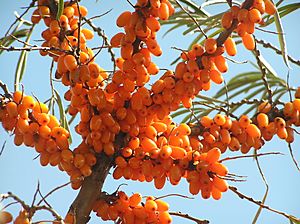Sea buckthorn oil facts for kids

Sea buckthorn oil is a special orange-red oil that comes from sea buckthorn plants. The most common plant used to make this oil is called Hippophae rhamnoides. These plants store oil in their fruit, so the oil can be taken from either the seeds or the fleshy part of the fruit (called the pulp).
The oils from the seeds and the fruit pulp are used in different ways. You can find them in dietary supplements, special foods that help your health (called nutraceuticals), and many skin care products.
Contents
What's Inside Sea Buckthorn Oil?
The seeds of sea buckthorn plants usually have about 7-11% oil. The fruit pulp has less oil, around 1.5-3%.
The oil from the seeds has a lot of polyunsaturated fatty acids. These are important fats that our bodies need. The oil from the fruit pulp has more monounsaturated fatty acids and special colorful compounds called carotenoids. Both types of oil also contain lots of vitamin E compounds, like tocopherols and tocotrienols, and plant sterols.
Different Kinds of Fatty Acids
The oils from sea buckthorn seeds and pulp have different types of fats. Seed oil mainly contains linoleic acid and α-linolenic acid. These are important fats that the body cannot make on its own.
However, sea buckthorn pulp oil is different. It has a lot of palmitoleic acid (a monounsaturated fat) and palmitic acid (a saturated fat). Because of these differences, the two oils look and feel very different.
Sea buckthorn fruit oil is dark orange and thick. It stays liquid at room temperature but gets much thicker if you put it in the fridge. Seed oil, on the other hand, is light yellow and does not get solid when it's cold.
Not many other plant oils have so many of these special fatty acids. But because they have so many unsaturated fats, sea buckthorn oil can go bad quickly. This means it can turn rancid (smell or taste bad) if not stored properly.
Vitamin E Compounds
A type of vitamin E called α-Tocopherol is the main one found in sea buckthorn oil. Seed oil also has a good amount of gamma-tocopherol. These compounds are good for your body.
Carotenoids: The Color Makers
Carotenoids are the natural colors that give sea buckthorn berries their bright orange-red color. These compounds are found in both pulp oil and seed oil, but there are many more in the pulp oil.
The main carotenoids in pulp oil are beta-carotene, zeaxanthin, and lycopene. These are the same colorful compounds found in carrots and tomatoes!
Plant Sterols
Both the seed and pulp oils also contain a good amount of plant sterols. Beta-sitosterol is the most common type of sterol found in the berry.
How Sea Buckthorn Oil is Used
Sea buckthorn oil is often used in beauty products, especially creams and lotions for aging skin and dry skin. You might also find it in some shampoos and other products for hair care.
Sometimes, people have used it as a topical medication (something you put on your skin) for skin disorders. However, scientists are still studying if it truly helps or is safe for these uses. Taking sea buckthorn oil as a dietary supplement has not been shown to help with eczema.
For hundreds of years, sea buckthorn oil has been used in traditional medicine in Asia and Russia. In some East Asian countries, the fruit pulp oil is put on skin burns.
What Scientists Are Studying
Scientists are doing early research on sea buckthorn oil to see if it has any health benefits. As of 2018, there is no strong proof that it has any confirmed benefits.
Researchers are looking into whether sea buckthorn oil might affect blood pressure, cholesterol, and blood triglycerides. They are also studying if taking it by mouth can increase levels of beta-carotene and vitamin E in the blood, which are important antioxidants.

